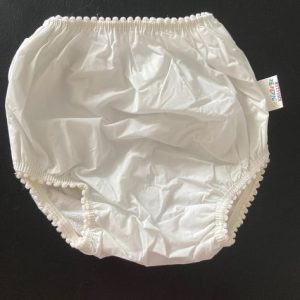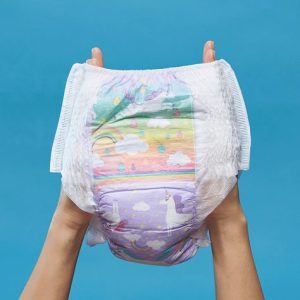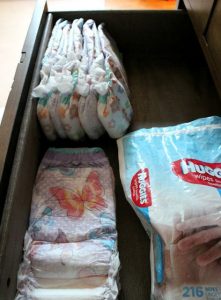Cloth diapering is a popular choice for parents looking for an eco-friendly and potentially cost-effective alternative to disposable diapers. However, for those new to cloth diapers, the concept can seem complex. This article will explore how cloth diapers work, the different types available, and the benefits of cloth diapering.
Understanding Cloth Diapers
Unlike disposable diapers that absorb and trap waste, cloth diapers are reusable and require washing. They consist of two main parts:
An absorbent inner layer:
This layer is typically made from natural fibers like cotton or hemp, or synthetic materials like microfiber. It absorbs your baby’s waste.
A waterproof outer cover:
This layer prevents leaks and keeps your baby dry. Outer covers can be made from PUL (polyurethane laminate) or other waterproof materials.
There are several ways to secure a cloth diaper to your baby:
Snaps:
These are easy to use and adjust for a snug fit.
Hook and loop closures (Velcro):
Convenient for quick changes, but may lose adhesiveness over time.
Pocket diapers:
These have a separate insert that goes inside a pocket. Inserts can be changed for increased absorbency.

Types of Cloth Diapers
How do cloth diapers work? There are several types of cloth diapers to choose from, each with its own advantages and disadvantages. Here’s a look at some popular options:
-
Prefolds: These are rectangular cloths made from absorbent materials. They require folding and wrapping around your baby before securing with a cover.
-
Fitted diapers: These one-size diapers are contoured to fit your baby’s shape and come with built-in absorbency.
-
All-in-one (AIO) diapers: These resemble disposable diapers in appearance and ease of use. They have an absorbent inner layer sewn into a waterproof outer shell.
-
All-in-two (AI2) diapers: These have a separate snap-in insert and a waterproof outer cover. AI2 diapers offer more customization for absorbency needs.
Benefits of Cloth Diapering
Cloth diapering offers several potential benefits, including:
-
Environmental friendliness: Cloth diapers reduce waste compared to disposable diapers.
-
Cost savings: While there’s an upfront cost for cloth diapers, they can be reused for multiple children, leading to long-term savings.
-
Gentler on baby’s skin: Cloth diapers are free of chemicals and fragrances that can irritate some babies’ skin.
-
More customizable: Cloth diapers come in various styles, materials, and absorbency levels to suit your baby’s needs.
Getting Started with Cloth Diapering
How do cloth diapers work? If you’re considering cloth diapering, here are some tips to get you started:
-
Do your research: Learn about the different types of cloth diapers and choose ones that fit your lifestyle and preferences.
-
Invest in a good quality diaper sprayer: This will help you easily rinse waste off the diapers before washing.
-
Develop a laundry routine: Cloth diapers require washing and drying after each use. Plan a routine that works for you.
-
Join a cloth diaper community: There are online forums and local groups where you can connect with other cloth diapering parents for support and advice.
Cloth Diapering: A Rewarding Choice
Cloth diapering can be a rewarding experience for parents who are committed to a more sustainable and potentially cost-effective diapering solution. By understanding how cloth diapers work, the different types available, and the benefits they offer, you can make an informed decision about whether cloth diapering is right for your family.

Let’s explore some additional factors to consider with cloth diapering:
-
Washing Routine: Cloth diapers require washing after each use. This can involve rinsing off waste with a diaper sprayer, storing soiled diapers in a pail, and then laundering them according to the diaper material and manufacturer’s instructions.
-
Drying Options: Cloth diapers can be air-dried or tumble-dried on low heat. Avoid using high heat settings, which can damage the diapers.
-
Nighttime Diapering: Some parents choose disposable diapers for nighttime use due to increased absorbency needs. However, there are also nighttime cloth diapering options available, like specifically designed inserts or doubling up inserts for extra absorbency.
Environmental Impact
Cloth diapering can be an eco-friendly choice. Disposable diapers contribute significantly to landfill waste. However, the environmental impact of cloth diapering also depends on factors like washing practices and energy use.
Cost Considerations
Cloth diapers require an upfront investment. However, they can be reused for multiple children, potentially leading to long-term cost savings compared to buying disposable diapers throughout your child’s diapering stage.
The Choice is Yours
Cloth diapering is a personal decision. There’s no right or wrong answer. By weighing the benefits, considerations, and your lifestyle, you can decide if cloth diapering is the right choice for you and your family.
Beyond the Basics: Cloth Diaper Care and Accessories
We’ve covered the essential parts of a cloth diaper and how it works. Now, let’s explore some additional aspects of cloth diaper care and accessories that can enhance your cloth diapering experience.
Keeping It Clean: Cloth Diaper Laundry Routine
Washing cloth diapers is an important part of the routine. Here’s a general overview:
-
Solid waste: Most cloth diapers come with a diaper sprayer, a handy tool to rinse waste off the diaper before washing.
-
Storing soiled diapers: Use a designated pail with a lid to store soiled diapers until laundry day. This helps contain odors.
-
Washing cloth diapers: Washing instructions can vary depending on the diaper material. Generally, you’ll want to pre-rinse them, then wash with a gentle detergent on a cold or warm cycle. Avoid harsh chemicals or fabric softeners that can damage the diapers’ absorbency.
-
Drying: Air drying is preferred for cloth diapers, but tumble drying on low heat is also an option. High heat can damage the diapers.
Cloth Diapering Accessories: Enhancing Convenience
There are several accessories that can make cloth diapering more convenient:
-
Wet bags: These are waterproof bags for storing clean or wet diapers on the go.
-
Diaper liners: These disposable liners can help make cleanup easier, especially for solid waste. However, they are not always necessary and add to overall waste production.
-
Cloth diaper rash creams: Certain diaper creams can clog the absorbency of cloth diapers. Look for creams specifically designed for cloth diapers.
By understanding these additional aspects of cloth diaper care and accessories, you can establish a routine that works for you and your baby.








